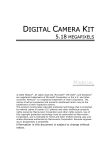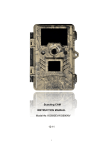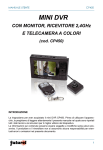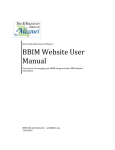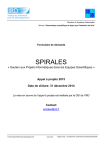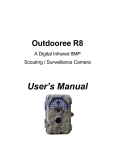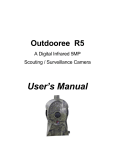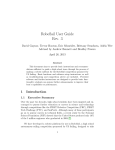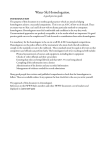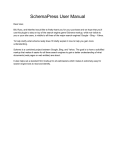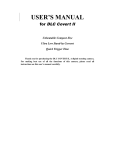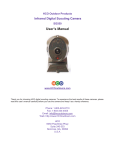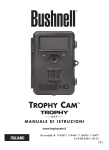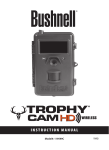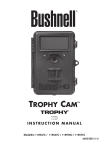Download User Manual-KG780NV
Transcript
Scouting CAM
INSTRUCTION MANUAL
Model #: KG780NV
12-11
1
TABLE OF CONTENTS
Page #
Introduction
General Description
Applications
Parts and Controls
Installing the Batteries and SD Card
Loading Batteries
Using an External Power Source
Inserting the SD Card
Using the KeepGuard CAM
The OFF,ON and SETUP Modes
OFF Mode
ON Mode
SETUP Mode
SETUP Mode Shortcut Keys/Functions
Using the SETUP Menu to Change Settings
Changing Parameter Settings in SETUP Mode
EXAMPLES-Changing the Settings of Some Common Parameters
The SETUP Menu-Parameters and Settings List w/Descriptions
Camera Name Input
Coordinate Input
Mounting and Positioning the KEEPGUARD CAM
Mounting
Sensing Angle and Distance Test
Switching ON the Camera
Playing Back/Deleting the Photos/Videos
Reviewing on the KeepGuard Cam LCD
Reviewing Images on an External Video Monitor
Deleting Photos or Videos
Reviewing Images Directly from the SD Card
Reviewing Images by Connecting the Camera to a Computer
Downloading the Photos/Videos
Troubleshooting/FAQs
Technical Specifications
2
3
3
4
4
6
6
6
7
8
8-9
8
8
9
9
10
11
12
15
19
19
20
20
21
21
22
22
22
23
23
24
24
26
29
INTRODUCTION
About the KEEPGUARD CAM
The KeepGuard Cam is a digital scouting camera. It can be triggered by any
movement of game in a location, detected by a highly sensitive Passive
Infra-Red (PIR) motion sensor, and then take high quality pictures (up to 8MP
still photos), or video clips.
Battery life has long been one of the biggest strengths of the KeepGuard Cam.
This camera is no different. It has low stand-by current and low day/night
power consumptions. The KeepGuard Cam is a rock star when it comes to
battery consumption. It consumes very little power (less than 0.28mA) in a
stand by (surveillance) state. This means it can deliver up to six months
stand-by operation time when the device is powered by eight AA alkaline
batteries, and up to twelve months utilizing lithium AA batteries. Once motion in
the monitored area is detected, the digital camera unit will be triggered
(typically within one second) and then automatically take photos or videos
according to previously programmed settings.
The KeepGuard Cam is equipped with built-in infrared LEDs that function as a
flash. It delivers clear photos or videos (in black & white) even in the dark and it
can take color photos or videos under sufficient daylight. The KeepGuard
Cam is designed for outdoor use and is resistant against water and snow.
Your trail camera is one of the latest generations of KeepGuard Trail Cam,
and includes many new or improved features, including:
• Auto PIR Sensitivity-the camera monitors ambient temperature conditions
and automatically adjusts the sensor/trigger signal to be more sensitive to
slight variations in temperature on hot days, less sensitive on cold days.
• Hyper Night Vision-The IR LED Flash array now has increased range,
brighter output and better coverage for improved nighttime images. The
nighttime pictures are clear and bright.
• Timed Scan - The “time lapse” feature added in last year’s models has been
enhanced with the addition of the option for a second block of recording with its
own start/stop times. Trigger signals generated by nearby wildlife activity will
still generate additional photos/videos as they normally would, independently
of the Timed Scan operation.
• IR LED Control - prevents overexposed flash photos in close range
applications.
3
The KeepGuard Cam has many more features such as Video with Audio,
wide screen or full screen format still photos, imprint able camera name (user
set) along with current data including temperature and moon phase.
Applications
The KeepGuard Cam can be used as a
Trail /Game Camera for hunting or scouting game.
Motion-triggered Camera: for Home, Office and Commune.
All other Outdoor Surveillance where Invasion Evidence is needed.
PARTS AND CONTROLS
The KeepGuard Cam provides the following connections for external devices:
USB port, SD card slot and external DC power (Fig. 1). A three way power
switch is used to select the main operating modes: OFF, SETUP, and ON (Fig.
2).
A control key interface with six keys is primarily used in SETUP mode to select
operational functions and parameters. As shown in Fig. 2, these keys are: UP,
DOWN, LEFT, RIGHT, OK and MENU. Four of the keys can also perform a
second function (shortcut operations in SETUP mode) in addition to their main
function. The DOWN key can be used to set the Video mode (movie camera
icon), and the UP key can set the camera to Photo mode (still camera icon).
The RIGHT key also serves as the manual shutter ("SHOT") button of the
camera and the OK key switches the camera to the playback ("REPLAY")
mode. These secondary functions are indicated by icons or text above the key
as shown in Fig. 2.
Figure 1: Connections For External Devices
SD Card Slot
USB Port
DC In Jack
Video Mic
4
Figure 2: Button and Switch Guide
LED IR Flash
Front View
Lens
Light Sensor
Lock Hole
Motion/Low Battery Indicator
PIR Sensor
Latch
Cable to Battery
Compartment
Video Mic
OK/Replay
Left
UP/Video
DC In Cover Plug
Down/Photo
RIGHT/Shot
Power/
Mode Switch
Menu
5
INSTALLING THE BATTERIES and SD CARD
Before you begin learning how to use your KeepGuard Cam, you will first
need to install a set of batteries and insert an SD card. Although that may only
take you a minute, there are some important notes about both batteries and
SD cards you should be aware of, so please take the time to read the
following directions and cautions:
Battery Slot
12+
Loading Batteries
3+
4-
5+
6-
78+
After opening the two latches on the right side of the
KeepGuard Cam, you will see that the KeepGuard
Cam has eight battery slots. Starting at the top of the
battery compartment slots 1, 2, 3 and 4 form one
group, while slots 5, 6, 7 and 8 form the other group,
each providing 6 volts in parallel. For maximum
battery life, you should install a full set of eight
batteries.
The KeepGuard Cam may also be operated by just
four batteries installed in the top group only (see
right), starting at slot 1. Battery life will be shorter with
4 batteries, but the camera will operate normally. Whether you use 4 or 8, be
sure to insert each battery with correct polarity (negative or "flat" end against
the long spring of each battery slot). KeepGuard recommends using eight new
lithium AA (Energizer® brand) or alkaline AA batteries. NiMh Rechargeable
batteries can also be used, but they might have a shorter life span due to their
reduced efficiency over time and at low temperature. It is also possible to use a
lead-acid external battery cell with 6V output or suitable AC adapter - see
below for more details.
Using an External Power Source (optional, user provided)
Optionally, you can connect an external 6V DC power source to the "DC In"
jack at the bottom of the KeepGuard Cam. It is recommended to use a power
source with a current output greater than 1000mA. However, during bright
daytime operation when no flash is required, the KeepGuard Cam can
function with much less current (>400mA). Please use a compatible power
source cable (not provided) to connect the external DC power source with the
power input jack of the KeepGuard Cam, making sure that the polarity is
correct.
Note: The power connector is a 4.0 x 1.7mm coaxial DC power plug with
positive ”tip” (inside pin) polarity (Radio Shack P/274-1532 or equivalent). If
both an external power source is connected and batteries are installed, the
6
KeepGuard Cam will be powered by the external power source. When the
batteries become weak, the low-battery indicator LED will glow blue, indicating
the batteries should be changed.
Inserting the SD Card
The KeepGuard Cams have 32MB internal memory, which can hold only
about 18 photos (12MP resolution). This is handy for testing and getting
familiar with the camera, but you will no doubt want to leave the camera
unattended for longer than a day, so using an SD card is recommended. Insert
the SD card (with the camera′s power switch in the OFF position) before
beginning to operate the camera. Don′t insert or remove the SD card when the
power switch is in the ON position. The KeepGuard Cam uses a standard SD
(Secure Digital) memory card to save photos (in .jpg format) and/or videos
(in .asf format). SD and SDHC (High Capacity) cards up to a maximum 32GB
capacity are supported. Before inserting the SD card into the card slot after
opening the camera's front cover, please make sure that the write-protect
switch on the side of the card is ″off″ (NOT in the ″Lock″ position). The
following describes how to insert and remove the SD card:
Insert the SD card into the card slot with its label side upwards (see below). A
"click" sound indicates that the card is installed successfully. If the wrong side
of the card is facing up, you will not be able to insert it without force - there is
only one correct way to insert cards. If the SD card is not installed correctly, the
device will not display an SD card icon on the LCD in SETUP mode (the SD
card icon displayed after switching to SETUP mode will have a ″lock″ symbol
inside it if the card is locked). Formatting the SD card by using the KeepGuard
Cam's "Format" parameter before using it for the first time is recommended,
especially when a card has been used in other devices (see ″Changing Menu
Parameter Settings″ for details).
To take out the SD card, just gently push in the card (do not try to pull it out
without pushing in first). The card is released from the slot and ready to be
removed when you hear the click.
WARNING
Be sure the camera′s power is switched OFF
before inserting or removing SD cards or batteries.
7
USING THE KEEPGUARD CAM
Once you've prepared your KeepGuard Cam by properly installing batteries
and an SD card, you could simply take it outside, strap it to a tree, switch it on
and leave and you might get some great photos that are exactly what you
wanted. However, we highly recommend that you first spend some additional
time indoors with this manual and your camera until you know a bit more about
what the 3-way switch and those control keys do. If nothing else, you'll
probably want to at least set the date and time so the camera will imprint them
(or not-it's your option) on your photos as they are taken, learn how to set the
camera to shoot video clips instead of still photos if you like, and read some
tips about mounting it on a tree.
THE OFF, ON, AND SETUP MODES
The KeepGuard Cam has three basic operational modes:
· OFF mode: Power switch in the OFF position.
· ON mode: Power switch in the ON position (LCD screen is off.)
· SETUP mode: Power switch at SETUP position (LCD screen is on).
OFF Mode
The OFF mode is the "safe" mode when any actions must be taken, e.g.,
replacing the SD card or batteries, or transporting the device. You will also use
OFF mode if you connect the camera to a computer′s USB port to download
your photos/ videos. When you are storing or not using the camera, you will
switch it to OFF. Please note that even in the OFF mode the KeepGuard Cam
still consumes power at a very low level. Therefore, it's a good idea to take the
batteries out of the battery compartment if the camera will not be used for a
long time.
ON Mode
Any time after the batteries and SD card have been inserted, you can switch
on the camera. When the power switch is moved to the top position, the
camera will enter into the ON (Live) mode. The motion indicator LED will blink
red for about 10 seconds. This interval allows time for you to close the
KeepGuard Cam′s front cover, lock it, and leave the monitored area. Once in
the ON mode, no manual controls are needed or possible (the control keys
have no effect). The KeepGuard Cam will take photos or videos automatically
(according to its current parameter settings) when it is triggered by the PIR
sensor′s detection of activity in the area it covers. You can either move the
power switch directly from OFF to ON mode, or stop at the SETUP position
first to change one or more settings, then move the switch to ON after you
8
have finished doing so.
SETUP Mode
In the SETUP mode you can check and change the settings of the KeepGuard
Cam with the help of its built-in LCD (or a monitor connected to the TV out
jack).These settings, found in the SETUP Menu, let you change the photo or
video resolution, interval between photos, switch the time imprint on, etc.
Moving the power switch to the SETUP position will turn on the LCD display,
and you will see an information screen that shows how many images have
been taken, the battery level, camera or video mode, etc. (see Fig. 3).
NOTE: Always move the power switch from OFF to SETUP mode. It is
possible that the camera could lock up if it is switched from ON to SETUP
mode. If this occurs, simply move the switch to OFF and then push it up
to SETUP again.
SETUP Mode Shortcut Keys/Functions
As mentioned earlier in “Parts & Controls”, four of the keys below the LCD
have secondary, "shortcut” functions when the camera is switched to SETUP
mode (but the MENU key has not been pressed):
• Press the UP key to quickly set the camera to shoot video clips.
• Press the DOWN key to quickly set the camera to take still photos.
• Press the RIGHT key to manually trigger the shutter. This is useful for testing
the camera. Make sure you are in SETUP mode, press the RIGHT key and a
few seconds later a photo or video (depending on how the camera was set) will
be saved to the SD card (or internal memory if no card is inserted). The
“number of images taken” counter on the bottom left of the LCD will increase
by one. If the display indicates "SD PROTECTED" when you press the SHOT
key, switch the camera OFF, remove the SD card and slide its protect switch
off.
• Press the OK key to replay (review or playback) photo/videos on the LCD
connected TV monitor. See “playing Back Photos/Videos” for more details.
9
Fig. 3: SETUP Information Screen
Image Resolution
# of Photos Taken
Camera Mode
Remaining Photo
Capacity
Time Stamp ON
Timed Scan ON
Battery Level
SD Card Status
Audio Rec On
Video Resolution
Video Mode
Available Video
Recording Time
Time Stamp ON
Field Scan ON
USING THE SETUP MENU TO CHANGE SETTINGS
The main purpose of the SETUP mode is to allow you to change the settings of
the camera’s parameters (15 different ones are available) so your KeepGuard
Cam operates exactly the way you want it to. You will do this by entering the
SETUP Menu and pressing the keys below the LCD display, which will show
you each parameter and its setting.
10
Changing Parameter Settings in SETUP Mode
A wide range of options or "parameters" are provided to allow you to set
KeepGuard Cam to your operational preferences. To change the setting of
any parameter you must first switch to the SETUP mode. Once in SETUP
mode, pressing the MENU button will allow you to select any parameter and
change its setting. The name of the parameter and its current setting will be
shown on the LCD. Pressing the RIGHT or LEFT key scrolls to the next or
previous parameter (RIGHT key to move on to the next parameter and LEFT
key to go back to the previous parameter), and pressing the UP or DOWN key
lets you select a different setting for the currently displayed parameter. Once
you have selected your preferred new setting for a parameter, press the OK
button to save the new setting (actually change it). When you are finished
changing the settings of one or more parameters, press MENU again to exit
the SETUP menu. MENU can also be pressed anytime you want to cancel
changing a parameter's setting after a new setting has been selected (but OK
has not been pressed yet). After setting the parameters to your preferences,
be sure to move the switch to ON to begin actually taking photos or videos. No
images will be captured if the switch is left in the SETUP position (unless you
press the RIGHT/Shot key after exiting the menu), the camera will power off
automatically after a few seconds with no key pressed.
The following shows how to set a parameter on KeepGuard Cam models:
•
On the color LCD display model, all the available settings for the currently
displayed parameter are shown on one screen, with a checkmark next to
the current setting (Fig. 4a). To change the setting, first use the Right
/Left key, then press it until you reach the parameters you want to set,
then use UP/DOWN keys to highlight (select) the new setting you want
(Fig. 4b), then press OK to “Set” (“Execute”) the actual change to the
selected setting. The checkmark will appear next to your new setting to
confirm this (Fig. 4c).
Fig. 4: Selecting Parameter Settings
4A-Press MENU
4B-Press DOWN
11
4C-Press OK
EXAMPLES - Changing the Settings of Some Common Parameters
Following this page, you will find tables listing all of the parameters found in the
SETUP Menu, along with their possible settings (or range of settings), and a
detailed description of what the parameter controls and what the settings do. If
you read the previous section detailing how to select parameters and change
their settings, you should be able to dive right in, find the parameter(s) you
want, and setup the camera to your preferences, but maybe you'd rather walk
through an example or two first:
To change any parameter's setting, always start with the power switch in the
SETUP position. After the LCD comes on, press the MENU key.
The first parameter you will see when you first enter the SETUP Menu is
"Mode". To change it from its default setting of "Camera" (still photos) to
"Video" (shoot video clips), press the DOWN key to highlight "Video" (color
viewer models). Press the OK key to "execute" (Set) the new setting you
have selected for this parameter.
Now press the RIGHT key to move to another parameter in the Menu.
Pressing it four times will take you to ″Video Length″. Try using the UP and
DOWN keys to scroll through the range of settings, then press OK to lock in
your setting for the length of each video clip the camera shoots.
Pressing the RIGHT key several more times will get you to the ″Default Set″
parameter. Highlight or select ″Execute″ (using UP or DOWN) and press OK to
restore all parameters (including the Mode and Video Length parameters you
changed a minute ago) back to their original factory default settings. The
default settings for each parameter are indicated in bold type in the SETUP
Menu tables on the next several pages.
Be sure to set the current date and time, using the ″Set Clock″ parameter if you
choose to change the ″Time Stamp″ parameter setting to ″On″ since that will
12
tell the camera to imprint the date and time on each of the images it captures.
Timed Scan with Live Trigger Feature
Timed Scan is a revolutionary new feature for the KeepGuard Cam, which
allows you to monitor your food plots or field edges with time lapse images or
video. When set to “On”, the KeepGuard Cam will take a photo (or record a
video clip) automatically at your choice of intervals (for example, once every
five minutes) during one or two blocks of time you set up for each day, without
requiring a trigger from an active animal. This has the advantage of giving
you the ability to monitor the edge of a field that might be 50 or 150 yards away
from the camera out of the PIR sensor’s range. The result is an effective range
much greater than it would normally be, with the camera dependent on triggers
generated by nearby animals. This is a great tool for hunters to scout an entire
field with only one camera. If an animal does enter the area covered by the PIR
sensor and generate a trigger event during a time in between the Timed Scan
intervals you set, the camera will capture an image or video just as it normally
would, based on your other menu settings. Here’s how to setup and use
Timed Scan (be sure you’ve set the current time in “Set Clock” first, so your
Timed Scan recording will stop and start at the correct times of day):
1. Move the main switch to SETUP, then press MENU.
2. Keep pressing the RIGHT key, stepping through the Setup Menu until you
reach Timed Scan.
3. Press the UP key to select On, and press OK. You will see "A", representing
the first block of time you can define (a second block of time later in the day,
"B" can also be setup if you wish). Press OK . This takes you to the screen to
set Start and Stop times, which determines the clock times when the first block
of Timed Scan recording will begin and end for each day. You can set these
times to the exact hour and minute you want, for a recording “window” that
lasts anywhere from just a minute to a full 24 hours.
4. Set the [Start] and [Stop] times, beginning with the Start hour, using the
UP/DOWN keys to change the setting. The hour setting is based on a 24-hour
clock, with “00” hours = midnight, “12” hours= noon, “23” hrs. = 11PM, etc. To
move to the next setting, press the RIGHT key, change the minute for the Start
time with UP/DOWN, then on to the hour and minute settings for the Stop time.
5. After you finish setting the Stop minutes, press OK to confirm your settings
for the first block of Timed Scan recording. If desired, you can create a second
block of time by pressing the DOWN key to select "B"), then press OK and
follow the same process to set Start and Stop times for Timed Scan block "B” .
13
As an example of how you might use these two available time blocks, you
could setup Timed Scan time block "A" for the dawn hours from 6 AM to 8 AM,
and block "B" to capture images between 5:30 and 7 PM. No Timed Scan
recording would occur from 8 AM to 5:30 PM, or from 7 PM to 6 AM.
6. After setting Start/Stop times to define Timed Scan block "A" and/or "B",
press OK, then press the UP or DOWN key to select "Interval" and press OK
(Step 6). The Timed Scan "Interval" setting lets you control how often a photo
or video clip is recorded during the block(s) of time you defined with the Start
and Stop settings. Your options are 60 minutes, 30 minutes, 15 minutes, 5
minutes (this is the default), or 1 minute (still photo mode only). Use the
UP/DOWN keys to select your preference, then press OK to save it (Step 7).
Note: for videos, "Interval" is independent of the Length of each video
recording - it’s how often videos are recorded, not how long each one lasts.
7. Here’s an example of how the camera would operate, based on the
following Timed Scan settings:
Timed Scan: On
Timed Scan A:
[Start]: 6:00
[Stop]: 8:00
Timed Scan B:
[Start]: 17:30
[Stop]: 19:00
Interval: 15M
These settings would cause the camera to capture a photo (or video, if the
camera is set to that mode) once every 15 minutes, beginning at 6 AM, until
the Timed Scan "A" recording block stops at 8:00 AM. Later that day, the
camera would again take a photo or video every 15 minutes between 5:30 PM
and 7:00 PM (during Timed Scan time block "B"). The next day, the camera
would again record an image or video once every 15 minutes between 6:00
and 8:00 AM, and between 5:30 and 7:00 PM. No Timed Scan recording would
occur from 8 AM to 5:30 PM, or from 7 PM to 6 AM. Remember, Timed Scan
recording is independent of normal triggers due to animal activity–even if no
animals enter the IR sensor coverage zone, an image or video will still be
captured every 15 minutes during the block(s) of time. If an animal triggers the
camera “in between” the 15 minute intervals, it will be recorded, same as it
would if you had setup the camera with Timed Scan turned Off.
Note: Timed Scan settings of frequent intervals and/or long periods between
14
start and stop time can reduce battery life.
Step1: Set Timed Scan to “ON”
Step 2: Press OK to select A or B .
and set the Interval
Step 3: Set start and stop time
The SETUP Menu Parameters and Settings List Descriptions
Parameter
Settings
(Bold=default)
Mode
Camera
Video
Dual
Image Size
(only affects
still photos)
8M Pixel
5M Pixel
3M Pixel
Image
Format
Full screen,
Wide screen
Description
Selects whether still photos or video
clips are captured when the camera is
triggered.
Selects resolution for still photos from
3 to 8 megapixels. Higher resolution
produces better quality photos, but
creates larger files that take up more of
the SD card capacity (fills up faster).
5M is a good compromise between
quality and file size.
Select 4:3 (Full screen, like old TV
sets) or 16:9 (wide screen, like new flat
TVs ) “aspect ratio” for still photos on a
TV set or computer monitor, you can
set the format to match it.
15
Capture
Number
(only affects
still photos)
1 Photo
2 Photo
3 Photo
IR LED
Control
(multi-Flash
feature)
High, Medium, Low
Camera
Name
Input
(See ”Using the
Setup Menu Input
Screens”)
Video Size
(only affects
video clips)
1920X1080;
1280X720;
848X480
Video
Length
(only affects
video clips)
10S (second)
(default, with 5S to
60S, possible
range)
Selects how many photos are taken in
sequence per trigger in Camera mode.
Please also refer to the Interval
parameter.
Controls how many LED lamps fire
when images are taken in low
light. ”High” = all 32 LEDs fire, which is
the default setting. Set to medium or
Low if you are getting overexposed
flash photos or will place the camera at
very close range to the subjects you
want to photograph. In general, select
High if most of your intended subject
will cover 30ft. range, and Low for
subjects less than 15ft. away. Note: in
video mode, 24 LEDs fire in both
High & Medium (default) setting. Set
to low if videos are overexposed.
Allows the user to set a custom name
for the camera. Useful for ID purposes
when multiple cameras are setup,
since each camera will imprint its
name on all photos (but not videos) it
captures.
Selects video resolution (in pixels per
frame). Higher resolution produces
better quality videos, but creates larger
files that take up more of the SD card
capacity (fills up faster). 640x360 is
VGA video in standard 4:3 format.
Sets length per captured video clip.
Settings begin with 10 second default
when parameter is first selected. After
stepping down to 5S, video length
settings start over at 60S.
16
Selects the length of time that the
camera will "wait" until it responds to
any additional triggers from the PIR
after an animal is first detected and
remains within the sensor′s range.
During this user set "ignore triggers"
interval, the camera will not capture
(60M-1M are set in
photos/ videos. This prevents the card
one minute
from filling up with too many redundant
increments,
images. Settings begin with 10 second
59S-1S are set in
default when parameter is first
one second
selected. Note: after setting down
increments)
past 1S, settings start over at 60M.
Selects the sensitivity of the PIR
sensor. The ″High″ setting will make
the camera more sensitive to infrared
(heat) and more easily triggered by
motion, and the ″Low″ setting makes it
less sensitive to heat and motion. The
Normal, High,
High setting can be useful when the
Low, Auto
ambient temperature is warm (making
it more difficult for the sensor to detect
animals), and the Low setting may help
in cold weather if the camera is being
triggered too often by anything warmer
than the surroundings.
This parameter defines a certain time
period in a day when the camera can
be triggered, while the rest of the time
ON;OFF
the device is shut off. The effective
value ranges from 00:00 to 23:59.
Deletes (erases) all files stored on a
card to prepare it for reuse. Always
format a card that has been previously
used in other devices. Caution! Make
Execute
sure you have downloaded and
(followed by an backed up any files you want to
additional No/Yes)
preserve first! Press OK to execute
(then select Yes and press OK again
on color viewer models), press MENU
(or select NO then press OK) to exit
without formatting.
10S (second)
(default, with a 60M
(minute) to 1S
(second) range of
settings available.)
Interval
Sensor
Level
Time
Period Set
Format
17
OFF, On
Select ″On″ if you want the date & time
(that the photo was captured)
imprinted on every photo, select ″Off″
for no imprint.
Set
Press OK and use the UP/DOWN keys
(to
change
the
setting)
and
LEFT/RIGHT keys (to move to the next
field) to set the hour (24-hr format
only, ″00″ = midnight, ″12″ = noon and
minute, and then (on the lower row),
the year, month and date.
On, OFF
Select "on" if you want the camera to
shot at a specified internal. You can set
"start" time, "stop" time and "internal".
Select "off" if you don't want to use the
timed scan.
ON,OFF
Allows the user to input latitude and
longitude coordinates for the camera’s
location. This will be embedded in the
files saved on the camera’s SD card (if
“ON” is selected). This makes it
possible to see each camera’s location
as a “pushpin” on Google Earth maps
when reviewing a folder full of photos
from multiple cameras, or use other
“geotag” capable software (Picass,
etc.)
Set Video
Sound
On, OFF
Press "on" and the camera will record
the sound when in video mode. Press
"off" and the sound will be turned off.
Image
Recycle
ON,OFF
(NOTE:
Setting
Image Recycle is
not recommended
when using 16GB or
higher capacity SD
cards)
Select “ON” if you want the oldest
photos/videos to be replaced by new
images once the SD card is full. Select
“OFF” if you want operation to stop
when the card is full.
Time
Stamp
(only affects
still photos)
Set Clock
Set Timed
Scan
Coordinate
Input
18
Password
Default
ON,OFF
Cancel, Execute
Select "on" to set a password then
input the password. Select "off" to
close the password function.
Select ″Execute″ and press OK to
restore all parameters to the original
factory default settings. If the camera
is behaving oddly and you think you
may have changed the setting for
something accidently (but aren′t sure
which one), this will reset all
parameters to their most commonly
used or “generic” settings.
Camera Name Input
After selecting the Camera Name parameter (the only setting is “Input”), press
OK. If necessary delete the previous or default name by pressing the RIGHT
key until the backspace symbol “←” is highlighted then keep pressing OK.
Select (highlight) each alphanumeric character you want using the
LEFT/RIGHT keys and pressing OK after each one to set it. When finished
naming the camera press MENU to save the name to memory.
Coordinate Input
After selecting the Coordinate Input parameter press UP or DOWN to select
the ON setting and press OK. The Latitude and longitude for any location
where you plan to place the camera can be obtained at many websites, for
example: http://itouchmap.com/latlong.html. You can enter a nearby street
address, zip code or use the various types of maps to locate the approximate
position. The format you will need to use to enter the coordinates in the
KG780NV menu screen is shown on the next page:
19
N=North
S=South
Degrees
Latitude
(3 digits)
Minutes
Seconds
Latitude-----(La)N000,00’00”
Longitude--(Lo)W000,00’00”
W=West
E=East
Degrees Minutes Seconds
Longitudes
(3 digits)
MOUNTING AND POSITIONING the KEEPGUARD CAM
Mounting
After you′ve set up the camera′s parameters to your personal preferences at
home or in your truck, you′re ready to take it outside and slide the power switch
to ″ON″. When setting up the KeepGuard Cam for scouting game or other
outdoor applications, you must be sure to mount it in place correctly and
securely. We recommend mounting the KeepGuard Cam on a sturdy tree with
a diameter of about 6 in. (15cm). To get the optimal picture quality, the tree
should be about 16-17 ft. (5 meters) away from the place to be monitored, with
the camera placed at a height of 5-6.5 ft. (1.5~2 m). Also, keep in mind that
you will get the best results at night when the subject is within the ideal flash
range, no farther than 45′ (14m) and no closer than 10′ (3m) from the camera.
There are two ways to mount the KeepGuard Cam: using the provided
adjustable web belt, or the tripod socket.
Using the adjustable web belt: Fig. 5 illustrates using the web belt on the
KeepGuard Cam. Push one end of the belt through the two brackets on the
back of the KeepGuard Cam. Thread one plastic buckle part onto each end of
the belt. Fasten the belt securely around the tree trunk by clicking the buckle
ends together after tightening the belt so there is no slack left.
20
Fig. 5: Attaching the Belt
Using the tripod socket : The camera is equipped with a socket at the bottom
end to enable mounting on a tripod or other mounting accessories with a
standard 1/4-20 thread.
Sensing Angle and Distance Test
To test whether the KeepGuard Cam can effectively monitor the area you
choose, this test is recommended to check the sensing angle and monitoring
distance of the KeepGuard Cam. To perform the test:
• Switch the KeepGuard Cam to the SETUP mode.
• Make movements in front of the camera at several positions within the
area where you expect the game or subjects to be. Try different distances
and angles from the camera.
• If the motion indicator LED light blinks, it indicates that position can be
sensed. If it does not blink, that position is outside of the sensing area.
The results of your testing will help you find the best placement when mounting
and aiming the KeepGuard Cam. The height away from the ground for placing
the device should vary with the animal size appropriately. In general, 3 to 6 feet
is preferred.
You can avoid potential false triggers due to temperature and motion
disturbances in front of the camera by not aiming it at a heat source or nearby
tree branches or brush (especially on windy days).
Switching ON the Camera
Once you switch to the ON mode, the motion indicator LED (red) will blink for
about 10 seconds. This gives you time to close and lock the front cover of the
KeepGuard Cam and then walk away. During this time, the motion indicator
LED will blink red continuously. After it stops blinking, the PIR is active, and
21
any motion that is detected by it will trigger the capture of photos or videos as
programmed in the SETUP Menu. Be sure you have read the descriptions of
the Capture Number, Video Length, Interval and Sensor Level parameters.
Please note, the PIR is strongly sensitive to ambient temperature. The greater
the temperature difference between the environment and your subject, the
farther the possible sensing distance. The average sensing distance is about
45 ft.
Before leaving the camera unattended, please check for the following:
• Are the batteries or DC power supply inserted/connected with correct polarity
and is the power level sufficient?
• Does the SD card have sufficient available space and is its write-protection
(lock) switch off?
• Is the Power switch in the ON position? (do not leave it in SETUP).
PLAYING BACK/DELETING the PHOTOS/VIDEOS
After you have setup, mounted and activated your KeepGuard Cam, you will
of course be eager to return later and review the images it has captured for you.
There are several different ways this can be done.
Reviewing Images on the KeepGuard Cam LCD (Models with Color
Viewer only)
• Put the power switch in SETUP mode (switch to OFF first).
• Push the OK (Replay) key to enter image review mode.
• Use the UP/DOWN keys to scroll through your photos or videos. The right
corner of the display will indicate ″JPG″ for still photos, and a film icon for
video files. Press the RIGHT (Shot) key to review a video.
• Push MENU to delete an image. Image delete mode works as described
below. To exit image review mode, press the OK key.
Reviewing Images on an External Video Monitor
A TV monitor can also be used to play back pictures (or videos) from the
device. Connect a TV monitor or a viewing device (such as a digital picture
frame) that has a standard composite video input (RCA jack) to the
KeepGuard Cam′s ″TV Out″ mini jack using the supplied cable. Then:
22
• Put the power switch in SETUP mode (switch to OFF first).
• Press the OK key. The most recently captured
image will be shown on the video monitor.
For video clips, press the SHOT (RIGHT) key
to start playing, press again to stop.
• Press the UP key for the previous photo or
video and the DOWN key for the next one.
When viewing images, the total number of
all images in the SD card and the index of the
displaying image are shown in the center of LCD and at the bottom of the
video monitor respectively.
• Press the OK key to return to live preview state (SETUP mode) when
playback is finished.
Deleting Photos or Videos
If you see a photo or video during playback on the LCD or video monitor that
you want to delete, it can be done easily without leaving SETUP mode:
• Press the MENU key. You will see the first ″Delete″ screen, which lets you
select the option to delete only the currently displayed photo/video, or all
photos/videos (see below).
• Highlight the ″Delete Current″ or ″Delete All″ option, then press OK.
Next, select ″Yes″ and press OK to erase only the last displayed photo or
video (if you selected ″Delete Current″), or every photo and video file on the
card (if you selected ″Delete All″ or select ″No″ and press OK to cancel the
operation without deleting any files.
NOTE: After deleting a picture or a video file, the deleted files can′t be
restored! It is also possible to delete all files from the card by using the
Format parameter.
Reviewing Images Directly From the SD Card
This is the most popular method of viewing images. Unmounting the camera
and taking it to your computer isn′t very convenient, you may find it easier to
23
just take the card out. By removing the SD card (swapping it for a new empty
card if you like) and taking it to your home or campsite to view the images by
using an SD card ″reader″ (user supplied) connected to your computer (some
computers and TVs have a built in SD card slot), you can leave the camera in
place ready to capture more images. Once connected, the card reader works
the same way as described below. Please read that section if you have any
problem finding your files.
Reviewing Images by Connecting the Camera to a Computer
You can always unmount the entire camera from the tree and connect its USB
port to a computer and it will be recognized as a ″removable disk″, without the
need to install any drivers or software. When using a PC (or Mac) to view
photos (or video clips), first connect the device to the computer with the
supplied USB cable. Then use commercial software with an image browser
feature, or an image browser included with the PC's operating system to view
images saved on the SD card in the folder \DCIM\100EK113. Each new image
or video will be numbered incrementally in order of the time it was captured.
For example, you will see file names such as “PICT0001.JPG” or
“PICT0001.ASF”. Through the file format suffix you can distinguish whether
the file is a still photo (with suffix .jpg) or a video (with suffix .asf).
*″.ASF″ video files may require additional software for viewing on a Mac
The KeepGuard Cam supports 3 kinds of file system formats, FAT12, FAT16,
and FAT32. The default value is FAT16 to save photos and videos. Here are
some related notes:
• You don′t need to be concerned about the file system format of the
KeepGuard Cam unless your equipment has problems reading the SD
card. If this happens, please format the SD card with the KeepGuard
Cam or in your computer first and then insert the card into your
KeepGuard Cam and try again.
• The default file system format of the KeepGuard Cam is FAT16, which
most computers can read. If you format an SD card for the KeepGuard
Cam in your computer, you should choose the file system format FAT16.
Normally FAT16 is recommended unless you have another image viewer
that uses FAT12 or FAT32 format.
DOWNLOADING THE PHOTOS/VIDEOS
To download your photos/videos to a PC or Mac, first make sure the
KeepGuard Cam power switch is in the OFF position. Connect the supplied
cable to the camera′s USB port, then directly to a main USB port on your
computer. Do not use front panel/keyboard USB ports or unpowered ″hubs″.
24
The KeepGuard Cam will be recognized as a standard ″USB Mass Storage″
device (this may take several seconds the first time you connect it). If you
would rather leave your camera in the woods and just pull its SD card out, an
SD card reader works the same way as described in this section once the card
is inserted and the reader is connected to your computer.
With Windows XP or later, you can then simply use
the options in the pop-up window to copy, view, or
print your photos (right).
On all Windows OS, the KeepGuard Cam will also be
listed as a ″Removable Disk″ if you open the ″My
Computer″ window (on Macs, an icon will appear
on your desktop). The KeepGuard Cam′s photo files
are named″PICT0001.JPG″etc, and are located in the ″DCIM﹨100EK113″ folder
on this ″Removable Disk″. Video file names will end with ″.ASF″. You may copy
the photos/videos to your hard drive as you would any file. Just copy/paste or
drag the file names or icons to your drive or desktop.
After the photos are copied to your hard drive, you can disconnect the
KeepGuard Cam. (On Mac computers, drag the ″disk″ that appeared on your
desktop when the camera was connected into your Trash to ″eject″ it before
disconnecting.) The .jpg standard files from the KeepGuard Cam may be
viewed and edited with any photo software you choose to use. The ASF video
files may be viewed with Windows Media Player (version 7 or later) as well as
other video playback programs that may have been supplied with your
computer, or are available online.
*″.ASF″ video files may require additional software for viewing on a Mac.
25
Troubleshooting / FAQ
Battery life is shorter than expected
1. Battery life will vary with operating temperature and the number of images
taken over time. Typically, the KeepGuard Cam will be able to capture several
thousand images before the batteries die.
2. Check to make sure you have used new alkaline or lithium batteries.
KeepGuard recommends using 8 Energizer Lithium AA batteries in all
KeepGuard Cams to obtain maximum battery life.
3. Make sure that the power switch was turned to the ″On″ position and that
the camera was not left in ″Setup″ mode while in the field.
4. Make sure that you are using a good quality name brand SD card in your
camera. KeepGuard recommends SanDisk® brand SD Cards up to 32GB. Our
experience indicates that poor quality SD cards can sometimes reduce your
KeepGuard Cam battery life.
Camera stops taking images or won′t take image
1. Please make sure that the SD card is not full. If the card is full, the camera
will stop taking images.
2. Check the batteries to make sure that they are new alkaline or lithium AA
batteries. See note above about short battery life.
3. Make sure that the camera power switch is in the ″On″ position and not in
the ″Off″ or ″Setup″ modes.
4. Make sure that you are using a good quality SD card in your camera.
KeepGuard recommends SanDisk® SD Cards up to 32GB.
5. If the SD card has its write protect switch in the lock position, the camera
will not take images.
6. If you have used an SD card in another device before inserting it in your
KeepGuard Cam, you might want to try formatting the card using the ″Format″
parameter in Setup mode (make sure you have backed up any important files
first, as formatting will erase all previous files). In some cases, other devices
may change the formatting of the SD card so that it will not work properly with
the KeepGuard Cam.
Camera won′t power up
1. Make sure that you have installed at least 4 batteries (the required
minimum #) in the battery compartment, starting at the top, filling battery
spaces 1-4 with no ″gaps″. KeepGuard recommends using 8 Energizer⊕
Lithium AA batteries in all KeepGuard Cams.
2. Make sure that the batteries are installed correctly, observing proper
26
polarity. Always place the negative (lat) end of each battery in contact with the
spring side of its slot inside the camera.
3. After moving the switch from ″Off″ to ″Setup″ or ″On″, make sure that the
switch is correctly in position to ensure the proper mode (avoid
positions ″between″ two modes).
4. Do not move the switch directly from ″On″ to ″Setup″- always move the
switch all the way down to ″Off″ first, then back up to ″Setup.″
Still Photo and/or Video Quality Problems
1. Night photos or videos appear too dark
a. Check the battery indicator icon to see if battery power is full. The flash will
stop operating near the end of the battery life.
b. You will get the best results when the subject is within the ideal flash range,
no farther than 45′ (14m) from the camera Subjects may appear too dark at
greater distances.
c. Please note that when the Capture Number parameter is set higher
than ″1 Photo″, or with very short Interval settings, some images may appear
darker than others due to the quick response and rapid retriggering of the
camera, allowing less time for the flash to fully recharge before firing again.
2. Daytime photos or videos appear too dark
a. Make sure that the camera is not aimed at the sun or other light sources
during the day, as this may cause the auto exposure to produce darker results.
3. Night photos or videos appear too bright
a. You will get the best results when the subject is within the ideal flash range,
no closer than 10′ (3m) from the camera. Subjects may appear too light at
closer distances.
4. Daytime photos or videos appear too bright
a. Make sure that the camera is not aimed at the sun or other light sources
during the day.
5. Photos with streaked subject
a. In some cases with low lighting conditions and fast moving subjects, the
5MP or 8MP resolution settings may not perform as well as the 3MP setting.
b. If you have multiple images where fast moving subjects produce streaks on
the photo, try the 3MP setting instead.
6. Red , green or blue color cast
a. Under certain lighting conditions, the sensor can become confused resulting
in poor color images.
b. If this is seen on a consistent basis, then the sensor may need servicing.
Please contact KeepGuard customer service.
7. Short video clips--not recording to the length set
a. Check to make sure that the SD card is not full.
b. Make sure that the camera has good batteries in it. Near the end of the
battery life, the camera may choose to record shorter video clips to conserve
27
power.
Date/Time Stamp not appearing on images
Make sure that the ″Time Stamp″ parameter is set to ″On″.
Photos Do Not Capture Subject of Interest
1. Check the ″Sensor Level″ (PIR sensitivity) parameter setting. For warm
environmental conditions, set the Sensor Level to ″High″ and for cold weather
use, set the sensor for ″Low″.
2. Try to set your camera up in an area where there is not a heat source in
the camera′s line of sight.
3. In some cases, setting the camera near water will make the camera take
images with no subject in them. Try aiming the camera over ground.
4. Try to avoid setting the camera up on small trees that are prone
to being moved by strong winds.
5. Remove any limbs which are right in front of the camera lens.
PIR Sensor LED Flashes/Doesn′t Flash
1. When the camera is in the ″Setup″ mode, a special LED on the front of the
camera will flash when it senses motion. This is for setup purposes only and
will help the user aim the camera.
2. During use, the LED will not flash when the camera takes an image. This
is to help keep the camera hidden from game.
LCD Screen Issues
1. LCD screen powers on but no text is present.
a. After moving the switch from ″Off″ to ″Setup″ or ″On″, make sure that the
switch is correctly in position to ensure the proper mode (avoid
positions ″between″ two modes).
b. Do not move the switch directly from ″On″ to ″Setup″ - always move the
switch all the way down to ″Off″ first, then back up to ″Setup″.
2. LCD screen shows a faint black line after turning from ″Setup″
to ″On″.
a. The LCD will turn off when you slide the switch to the ″On″ position. In some
cases, this black line will appear and then fade in about 1 second. This is
normal and the camera will function properly.
3. Screen comes on but then powers off
a. Make sure that you have installed the SD card correctly.
28
Camera won’t retain settings
1. Make sure that you have been saving the changes to any parameter
settings that you made while in Setup mode, by pressing ″OK″ after changing
the setting. If you don’t save your new setting after changing it, the camera will
continue to use the original default setting for that parameter.
KG780 TECHNICAL SPECIFICATIONS
Image Sensor
5 Megapixel Color CMOS
Lens
f=7.45mm;FOV=55°;F/NO:2.8; Horizontal View Angel = 42°;
Auto IR-Cut-Remove (at night)
60'-75'(20m-25m)
IR-Flash Range
Display Screen
1.5 inch Std B&W Display;2.4 inch Color Display
Memory Card
SD or SDHC Card, Maximum capacity 32GB
Internal RAM
32M
Image Size
8MP(3264×2448); 5M(2592X1944); 3M(2048X1536)
Image Recycle
ON/OFF
Image Format
Full Screen/Wide Screen
Video Size
1920X1080;1280X720; 848X480
PIR Sensitivity
PIR with 3 sensitivity levels: High/ Normal/ Low/Auto
IR LED Control
High/Medium/Low
Operation
Day/Night
Response Time
<0.8s
Triggering Interval
1sec-60min programmable
Shutter Speed
1/10-1/2000sec.
Shooting Numbers
1-3 programmable
Video Length
5-60sec. programmable
Power Supply
8×AA recommended;4×AA as emergency power
Stand-by current
<0.28mA
Power Consumption
<200mA(+600mA when IR-LED Lighted)
Timed Scan
2X;programmable
Temperature Display
programmable
Password
programmable
Camera Name
Input
Moon Display
programmable
Audio Video
programmable
User Interface
LCD display
29
Interface
TV out(AVI);USB;SD card holder; 6V DC external
Security
Strap;1/4-20 attachment
Operating Temperature
-20-60 °C (Storage temperature: -30-70 °C)
Operating Humidity
5%-90%
Security Authentication
FCC/CE/RoHs/WEEE
30






























